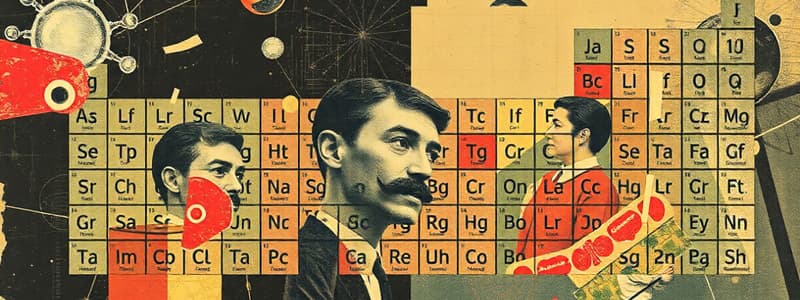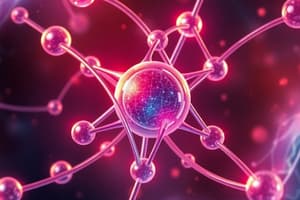Podcast
Questions and Answers
What defines the atomic number of an element?
What defines the atomic number of an element?
- Number of protons in an atom (correct)
- Total number of protons and neutrons
- Total mass of the atom
- Number of electrons in an atom
Which type of bond is formed by the transfer of electrons from one atom to another?
Which type of bond is formed by the transfer of electrons from one atom to another?
- Hydrogen bond
- Ionic bond (correct)
- Metallic bond
- Covalent bond
In a chemical reaction, which term describes the substances that are formed as a result?
In a chemical reaction, which term describes the substances that are formed as a result?
- Products (correct)
- Reactants
- Intermediates
- Catalysts
What is the significance of a pH value of 7 in the pH scale?
What is the significance of a pH value of 7 in the pH scale?
What is the main characteristic of a homogeneous mixture?
What is the main characteristic of a homogeneous mixture?
Which of the following states of matter has a definite shape and volume?
Which of the following states of matter has a definite shape and volume?
Which factor does NOT influence the reaction rate according to chemical kinetics?
Which factor does NOT influence the reaction rate according to chemical kinetics?
According to Le Chatelier's Principle, what happens when a system at equilibrium is disturbed?
According to Le Chatelier's Principle, what happens when a system at equilibrium is disturbed?
What is the primary function of acids in solution?
What is the primary function of acids in solution?
Which type of chemical reaction involves the breakdown of a compound into simpler substances?
Which type of chemical reaction involves the breakdown of a compound into simpler substances?
What is the primary focus of inorganic chemistry?
What is the primary focus of inorganic chemistry?
Which of the following is a characteristic of endothermic reactions?
Which of the following is a characteristic of endothermic reactions?
What is the significance of the groups in the periodic table?
What is the significance of the groups in the periodic table?
Flashcards are hidden until you start studying
Study Notes
Basic Concepts of Chemistry
- Matter: Anything that has mass and occupies space.
- Elements: Pure substances consisting of one type of atom; represented on the periodic table.
- Compounds: Substances formed by the chemical combination of two or more elements in fixed ratios.
Atomic Structure
- Atoms: Basic units of matter composed of protons, neutrons, and electrons.
- Protons: Positively charged particles found in the nucleus.
- Neutrons: Neutral particles also located in the nucleus.
- Electrons: Negatively charged particles orbiting the nucleus.
- Atomic Number: Number of protons in an atom; defines the element.
- Mass Number: Total number of protons and neutrons in an atom's nucleus.
Periodic Table
- Organized by increasing atomic number.
- Groups (columns) share similar chemical properties.
- Periods (rows) indicate energy levels.
Chemical Bonds
- Ionic Bonds: Formed through the transfer of electrons from one atom to another.
- Covalent Bonds: Formed by the sharing of electrons between atoms.
- Metallic Bonds: Involves the pooling of electrons in metals.
Chemical Reactions
- Reactants: Substances that undergo a chemical change.
- Products: Substances formed as a result of a chemical reaction.
- Types of Reactions:
- Synthesis: Two or more substances combine to form a new compound.
- Decomposition: A compound breaks down into simpler substances.
- Single Replacement: An element replaces another in a compound.
- Double Replacement: Exchange of ions between two compounds.
- Combustion: Reaction with oxygen producing heat and light.
States of Matter
- Solid: Definite shape and volume; particles are closely packed.
- Liquid: Definite volume but takes the shape of its container; particles are close but can move.
- Gas: No definite shape or volume; particles are far apart and move freely.
Solutions and Concentrations
- Solutions: Homogeneous mixtures of solute (substance being dissolved) and solvent (substance doing the dissolving).
- Concentration: Amount of solute in a given volume of solvent; commonly expressed in molarity (moles per liter).
Acids and Bases
- Acids: Substances that donate protons (H⁺) in solution; have a sour taste and turn blue litmus paper red.
- Bases: Substances that accept protons; have a bitter taste and turn red litmus paper blue.
- pH Scale: Measures the acidity or basicity of a solution; ranges from 0 (acidic) to 14 (basic), with 7 being neutral.
Thermochemistry
- Endothermic Reactions: Absorb heat from the surroundings.
- Exothermic Reactions: Release heat to the surroundings.
- Enthalpy (ΔH): Measure of heat change in a reaction.
Chemical Kinetics
- Reaction Rate: Speed at which reactants are converted to products.
- Influenced by:
- Concentration of reactants
- Temperature
- Presence of catalysts
Chemical Equilibrium
- State where the rates of the forward and reverse reactions are equal.
- Le Chatelier's Principle: If a system at equilibrium is disturbed, it will shift to counteract the disturbance.
Organic Chemistry
- Study of carbon-containing compounds.
- Functional Groups: Specific groups of atoms that determine the chemical reactivity of organic molecules (e.g., hydroxyl, carboxyl, amino).
Inorganic Chemistry
- Study of inorganic compounds, typically excluding carbon-based compounds.
- Focus on metals, minerals, and organometallic compounds.
Basic Concepts of Chemistry
- Matter is defined as anything that possesses mass and occupies physical space.
- Elements are pure substances made of a single type of atom, identified on the periodic table.
- Compounds consist of two or more elements chemically combined in fixed proportions.
Atomic Structure
- Atoms serve as the fundamental units of matter and consist of protons, neutrons, and electrons.
- Protons carry a positive charge and reside within the nucleus of an atom.
- Neutrons are neutral particles located in the nucleus, contributing to the atom's mass.
- Electrons are negatively charged and move in orbital paths around the nucleus.
- The atomic number represents the number of protons in an atom, which uniquely defines each element.
- The mass number is the total count of protons and neutrons present in an atom's nucleus.
Periodic Table
- The periodic table is arranged by increasing atomic number, providing a systematic layout of elements.
- Elements in the same group (column) exhibit similar chemical properties.
- Periods (rows) indicate the different energy levels occupied by electrons.
Chemical Bonds
- Ionic bonds result from the transfer of electrons between atoms, typically between metals and non-metals.
- Covalent bonds are established through the sharing of electrons to form stable compounds.
- Metallic bonds involve a communal sharing or pooling of electrons among metal atoms.
Chemical Reactions
- Reactants are the initial substances that undergo changes during a chemical reaction.
- Products are the substances generated as a result of a chemical reaction.
- Types of chemical reactions include:
- Synthesis: Combining multiple reactants to create a new single product.
- Decomposition: Breaking down a single compound into simpler products.
- Single Replacement: An element substitutes for another in a compound.
- Double Replacement: Ions in two compounds exchange places.
- Combustion: A reaction with oxygen that produces heat and light.
States of Matter
- Solids have a definite shape and volume, with particles tightly packed and vibrating in fixed positions.
- Liquids possess a definite volume but adapt to the shape of their container, with particles closely packed yet able to move.
- Gases lack definite shape and volume, with particles widely spaced and moving freely.
Solutions and Concentrations
- Solutions are homogeneous mixtures consisting of a solute (the substance being dissolved) and a solvent (the dissolving medium).
- Concentration quantifies the amount of solute present in a specific volume of solvent, commonly calculated as molarity (moles per liter).
Acids and Bases
- Acids release protons (H⁺) in solution, characterized by a sour flavor and the ability to turn blue litmus paper red.
- Bases accept protons, featuring a bitter taste and converting red litmus paper blue.
- The pH scale evaluates the acidity or alkalinity of a solution, ranging from 0 (acidic) to 14 (basic) with a neutral point at 7.
Thermochemistry
- Endothermic reactions absorb heat from the surroundings, leading to a temperature drop in their environment.
- Exothermic reactions release heat, causing an increase in surrounding temperature.
- Enthalpy (ΔH) represents the total heat change associated with a chemical reaction.
Chemical Kinetics
- Reaction rate measures how quickly reactants transform into products, which can be affected by factors like:
- The concentration of reactants
- Temperature variations
- The presence of catalysts that enhance reaction speed.
Chemical Equilibrium
- Equilibrium is the state where the forward and reverse reaction rates are balanced.
- Le Chatelier's Principle states that an equilibrium system will adjust to mitigate any disturbances imposed on it.
Organic Chemistry
- Focuses on the study of carbon and its compounds.
- Functional groups, such as hydroxyl, carboxyl, and amino groups, influence the chemical behavior and reactivity of organic molecules.
Inorganic Chemistry
- Concentrates on compounds that do not primarily contain carbon, including metals and minerals.
- Encompasses the study of organometallic compounds, which contain bonds between carbon and metals.
Studying That Suits You
Use AI to generate personalized quizzes and flashcards to suit your learning preferences.




